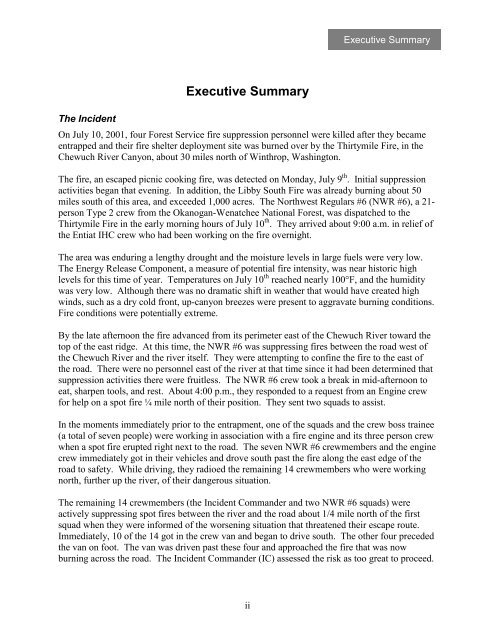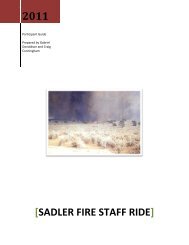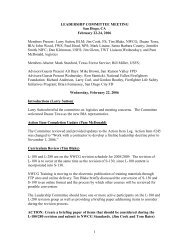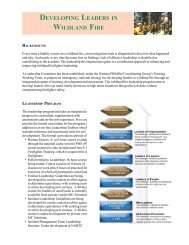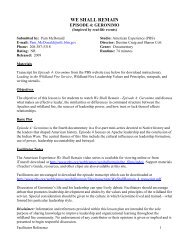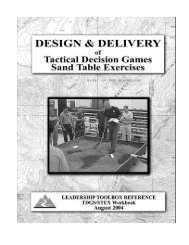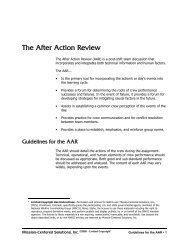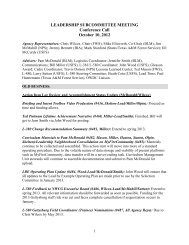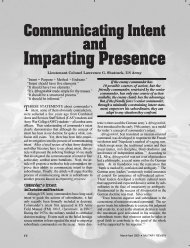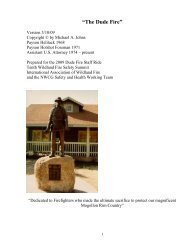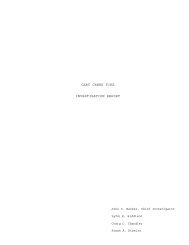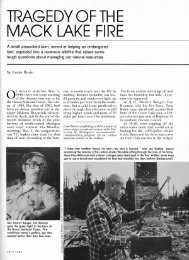Thirtymile Fire - USDA Forest Service
Thirtymile Fire - USDA Forest Service
Thirtymile Fire - USDA Forest Service
Create successful ePaper yourself
Turn your PDF publications into a flip-book with our unique Google optimized e-Paper software.
Executive Summary<br />
Executive Summary<br />
The Incident<br />
On July 10, 2001, four <strong>Forest</strong> <strong>Service</strong> fire suppression personnel were killed after they became<br />
entrapped and their fire shelter deployment site was burned over by the <strong>Thirtymile</strong> <strong>Fire</strong>, in the<br />
Chewuch River Canyon, about 30 miles north of Winthrop, Washington.<br />
The fire, an escaped picnic cooking fire, was detected on Monday, July 9 th . Initial suppression<br />
activities began that evening. In addition, the Libby South <strong>Fire</strong> was already burning about 50<br />
miles south of this area, and exceeded 1,000 acres. The Northwest Regulars #6 (NWR #6), a 21-<br />
person Type 2 crew from the Okanogan-Wenatchee National <strong>Forest</strong>, was dispatched to the<br />
<strong>Thirtymile</strong> <strong>Fire</strong> in the early morning hours of July 10 th . They arrived about 9:00 a.m. in relief of<br />
the Entiat IHC crew who had been working on the fire overnight.<br />
The area was enduring a lengthy drought and the moisture levels in large fuels were very low.<br />
The Energy Release Component, a measure of potential fire intensity, was near historic high<br />
levels for this time of year. Temperatures on July 10 th reached nearly 100°F, and the humidity<br />
was very low. Although there was no dramatic shift in weather that would have created high<br />
winds, such as a dry cold front, up-canyon breezes were present to aggravate burning conditions.<br />
<strong>Fire</strong> conditions were potentially extreme.<br />
By the late afternoon the fire advanced from its perimeter east of the Chewuch River toward the<br />
top of the east ridge. At this time, the NWR #6 was suppressing fires between the road west of<br />
the Chewuch River and the river itself. They were attempting to confine the fire to the east of<br />
the road. There were no personnel east of the river at that time since it had been determined that<br />
suppression activities there were fruitless. The NWR #6 crew took a break in mid-afternoon to<br />
eat, sharpen tools, and rest. About 4:00 p.m., they responded to a request from an Engine crew<br />
for help on a spot fire ¼ mile north of their position. They sent two squads to assist.<br />
In the moments immediately prior to the entrapment, one of the squads and the crew boss trainee<br />
(a total of seven people) were working in association with a fire engine and its three person crew<br />
when a spot fire erupted right next to the road. The seven NWR #6 crewmembers and the engine<br />
crew immediately got in their vehicles and drove south past the fire along the east edge of the<br />
road to safety. While driving, they radioed the remaining 14 crewmembers who were working<br />
north, further up the river, of their dangerous situation.<br />
The remaining 14 crewmembers (the Incident Commander and two NWR #6 squads) were<br />
actively suppressing spot fires between the river and the road about 1/4 mile north of the first<br />
squad when they were informed of the worsening situation that threatened their escape route.<br />
Immediately, 10 of the 14 got in the crew van and began to drive south. The other four preceded<br />
the van on foot. The van was driven past these four and approached the fire that was now<br />
burning across the road. The Incident Commander (IC) assessed the risk as too great to proceed.<br />
ii


